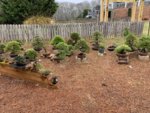Forsoothe!
Imperial Masterpiece
Yes. We differ on some fine points, namely drainage and length of service. I also lean towards pots that are deeper than most. I still have to hose down everything once a summer day and most pots are dry when I do that at the end of the day. I only have one JWP that is in a position that doesn't get watered every day, and no other pines in pots. I will be growing some pines in pots eventually and will water them somewhat less often, but will use the mix.We acquire the basic elements of our chosen soil mixes in the bag and mix it together according to our chosen recipe.
You have complained about mixes that wear out/break down in size and compact (if compact is the right word). I repot every other or third year for hardy, and every year for most, or every other year for some, tropicals. Some tropicals like BRT and bougainvilleas might be repotted twice in some years. Because of this repotting expectation/use, my mix does get used-up quicker than your mix. "Used up" meaning exchanged for new root mass in my case. It is safe to say (I think) that my deciduous and tropical trees should and do normally grow faster than your pines should normally grow. IMHO Pines would grow faster in my mix, too. I suppose, you might not find that true, or a positive, or neither.
How say you?

